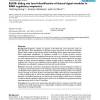Free Online Productivity Tools
i2Speak
i2Symbol
i2OCR
iTex2Img
iWeb2Print
iWeb2Shot
i2Type
iPdf2Split
iPdf2Merge
i2Bopomofo
i2Arabic
i2Style
i2Image
i2PDF
iLatex2Rtf
Sci2ools
BMCBI
2006
2006
BLISS: biding site level identification of shared signal-modules in DNA regulatory sequences
Background: Regulatory modules are segments of the DNA that control particular aspects of gene expression. Their identification is therefore of great importance to the field of molecular genetics. Each module is composed of a distinct set of binding sites for specific transcription factors. Since experimental identification of regulatory modules is an arduous process, accurate computational techniques that supplement this process can be very beneficial. Functional modules are under selective pressure to be evolutionarily conserved. Most current approaches therefore attempt to detect conserved regulatory modules through similarity comparisons at the DNA sequence level. However, some regulatory modules, despite the conservation of their responsible binding sites, are embedded in sequences that have little overall similarity. Results: In this study, we present a novel approach that detects conserved regulatory modules via comparisons at the binding site level. The technique compares the ...
| Added | 10 Dec 2010 |
| Updated | 10 Dec 2010 |
| Type | Journal |
| Year | 2006 |
| Where | BMCBI |
| Authors | Hailong Meng, Arunava Banerjee, Lei Zhou |
Comments (0)

